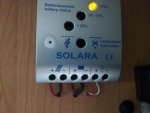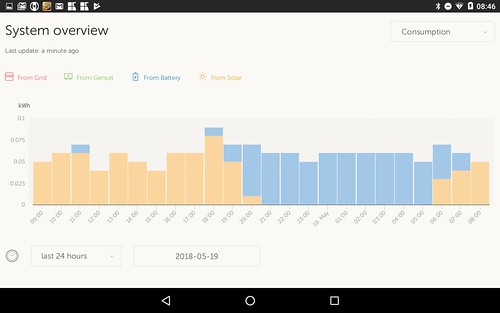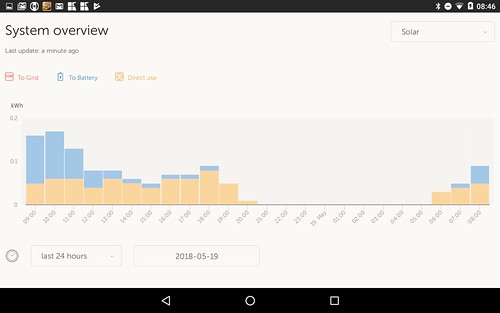oldish hippy
Full Member
- Posts
- 12,286
- Likes
- 7,837

My load output is connected to all my 12V equipment - lights, fridge, USB sockets etc. The output is 'live' whether or not there is any input from the solar panels. By doing this, I can also monitor how much power I am using, from the data output connection (or via bluetooth). So I can compare how much power I'm using with how much the panels are generating.
Another use of the load output is to prevent the batteries discharging too much. More details here, scroll down to 'Load Output'.
 Screenshot_20180519-084614 by David, on Flickr
Screenshot_20180519-084614 by David, on Flickr Screenshot_20180519-084637 by David, on Flickr
Screenshot_20180519-084637 by David, on FlickrThe MPPT unit is wired directly to the leisure batteries and has excess / spare power that is tapped via the LOAD terminals
I might be being stupid here so bear with me
the idea of the load terminals is to be able to use power generated which is in excess to that needed to recharge the battery - is that right?
what is the difference between (for example) charging your laptop from the 'load' terminal and charging it from the battery (which is being charged by the panel)?
surely the net result is the same?
All the MPPT controllers I've had have allowed you to programme when the load terminals are powered.
Perhaps they come on when the sun shines (to use spare power) or when it doesn't shine (to provide light in the dark) or on some sort of timer.
Generally I think they are of little use in a motorhome, but I have a solar setup in an isolated garden, and the load output is used to switch things off at night (regardless of sun situation) and also would switch the load off if the battery voltage fell too low (not going to happen without a major fault!)
I expect that the Vicron is no less programmable than cheaper brands. Hopefully the instructions are less incomprehensible. But I would simply ignore the load terminals in a motorhome setup. More to go wrong = potential problems.
Not sure what you are trying will work with the EBL or even if you want it to. I ‘think’ that the EBL puts charge to the leisure and starter batteries when charge is going through it, whether that be EHU, Solar or other. I don’t ‘think’ if leisure batteries are full it will pass everything to the starter battery.
It may do what you want but I suspect it will charge ALL batteries and if your solar has cut off because batteries are full you would be forcing an overcharge. I ‘think’ you would need to use a b2b to achieve what you want or split you panels through two controllers maybe so one goes through the EBL and the rest direct to batteries through controller.
I stress I only ‘think’ this so please contact someone who really knows before risking damaging your batteries. I tried to email Udo Lang earlier this year and got no response so not sure if I had email address wrong or he is no longer there, if he is he can tell you.
The Sterling B2B is designed to go in the engine compartment. The cooling fan is noisy and you won't want it in the inside of the vehicle unless in a cupboard.
Electrically, it is meant to be connected near the starter battery (or the alternator or the starter motor) to reduce voltage drop, in a well-ventilated place. Though with just 30A capacity, the cable length may not matter so much.
The writing on it is informative. If you think it is pseudo techno BS, you need to get someone who understands to translate it for you.
Once again, you miss the point. The B2B needs to be well-connected to the supply battery. That means it needs to be connected near the battery or near to something with a fat cable to the battery. Basically that means the starter or the alternator.
The solar controller cable will be relatively slight.
It has little to do with the charging power source, everything to do with the connection to the battery.
I think you are missing the point, not me.
There is NO supply battery in my configuration,
There is NO alternator in my configuration.
I am NOT trying to charge the engine battery from the auxiliary batteries, each battery bank is unaware of the other's existence.
The maximum current that is available from the MPPT load terminals to the BB1230 input is 15A.
The maximum current available from the BB1230 to the engine battery is 30A but it will never get to this ceiling as the source will be limited to 15A input.
Your suggestion to re-configure my installation will not meet the objective of "charge the engine battery from the solar/mppt load terminals".
If I followed your suggestion, I would have :
A) The main 40A MPPT output connected to the 95Ah engine battery
and
B) The 15A mppt load terminals connected to the 460Ah leisure batteries via some type of charging device.
In my book, this is a misallocation of resources and is perfectly senseless and 100% incorrect.
The Hymer only charges the engine battery via the Elektroblock. which in turn only charges the engine battery under 2 scenarios:
A) On the move, via the alternator,
and
B) While on an EHU/220v hookup.
Even when using the correct schaudt solar controller, plugged into the EBL, it doesn't charge the engine battery unless A or B above conditions are met.
There is a discrepancy whereas if I park up for any length of time, the engine battery discharges slightly each day with no correspondent re-charge available, while I have spare/excess capacity at the mppt/load terminals.
So to ensure that ALL my batteries get the benefit of free solar charging, I need to fill in this gap.
I could have done this by using a cheap pwm solar controller hooked up to the load terminals and fed to the engine battery, but I went for the sterling loud jobbie instead.
When installations are completed, I will have masses of leisure power available and an automatic re-charge/top-up of the engine battery and the leisure batteries, which will easily provide me with free electric that meets my currently known daily load.
makes perfect sense to me.
james
I used the Schaudt 1218 recommended PWM solar regulator on my last 2 vans and it comes with a wiring kit that takes seconds to fit and will charge the engine battery from solar panels. They did not make an MPPT regulator when I bought mine but I imagine it will do the same.
No, you have totally misunderstood what I suggest.
Your ideas seem ridiculous to me, so as a result my suggestions are totally unhelpful in assisting you need n achieving what you are trying to do. I had assumed you were trying to do something that is completely different. Sorry for my distraction from your chosen path.
Nothing you can do to adapt what I now think you are doing would make it seem a good idea to me.
Perhaps you need to re-read the techno babble about the B2B charger and how it works. If you can't send it back, they fetch a good price secondhand.
